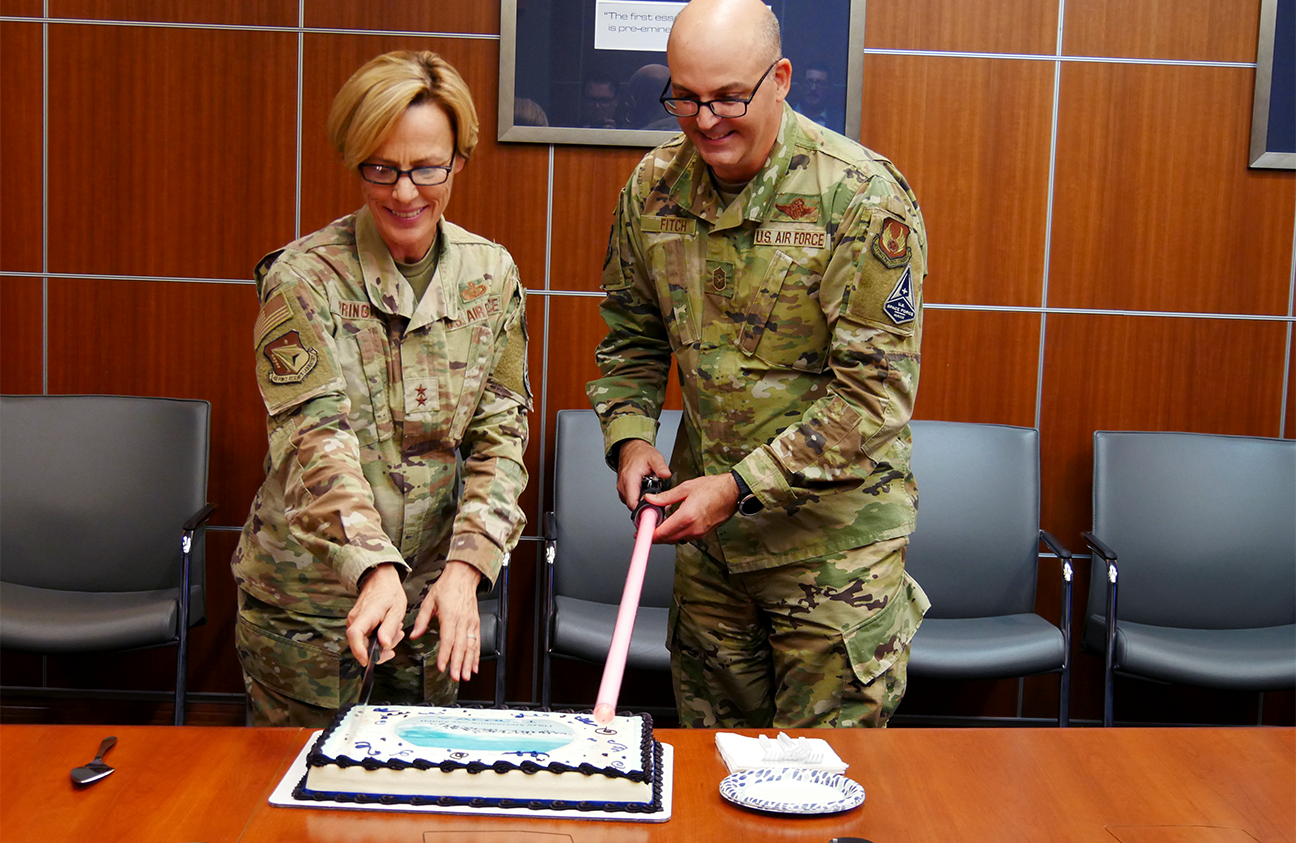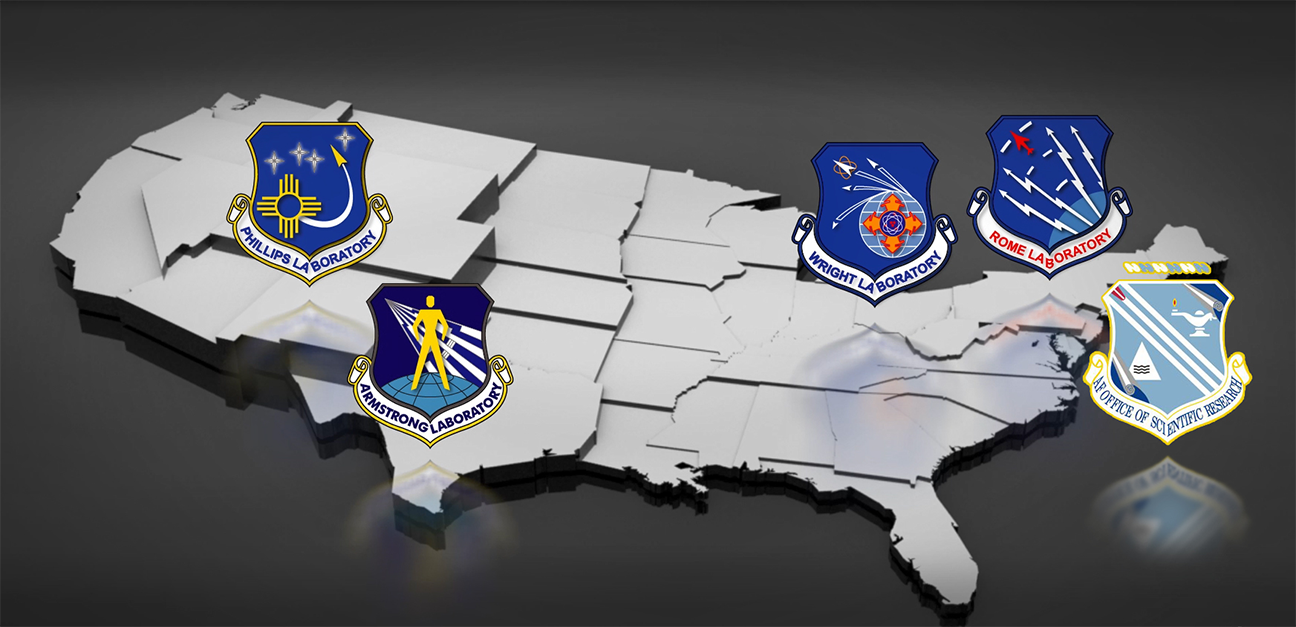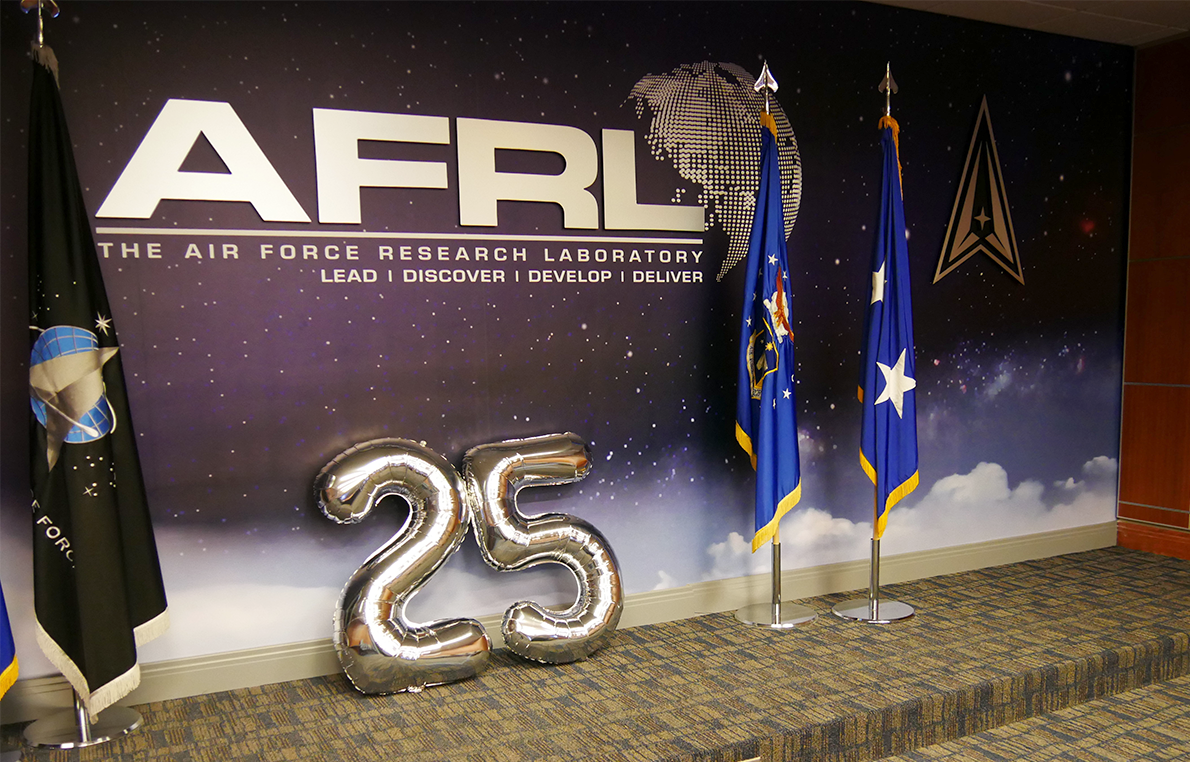AFRL celebrates unified science and technology enterprise
WRIGHT-PATTERSON AIR FORCE BASE, Ohio (AFRL) — The Air Force Research Laboratory, or AFRL, recognized the 25th anniversary of one AFRL at Wright-Patterson Air Force Base, Ohio, Oct. 28, 2022, with a celebration led by AFRL Commander Maj. Gen. Heather Pringle and Chief Master Sgt. James “Bill” Fitch, AFRL command chief. The event honored the unveiling of a brand new AFRL flag and shield during an Oct. 31, 1997 ceremony, signifying the coming together of four U.S. Air Force laboratory facilities, then called super labs, and the Air Force Office of Scientific Research, or AFOSR, under a unified organization.

Air Force Research Laboratory Commander Maj. Gen. Heather Pringle and Chief Master Sgt. James “Bill” Fitch, AFRL command chief, cut the cake to celebrate the 25th anniversary of one AFRL at Wright-Patterson Air Force Base, Ohio, Oct. 28, 2022. One AFRL refers to the 1997 coming together of four U.S. Air Force laboratory facilities, then called super labs, and the Air Force Office of Scientific Research under a unified science and technology organization. (U.S. Air Force photo / Justin Hayward)
In the years that followed, the new unified structure allowed AFRL to be more effective at advancing science and technology, or S&T, for the Department of the Air Force, or DAF.
“The coming together of the various super labs and AFOSR to form one AFRL has truly enabled our scientists, engineers and professionals to collaborate across technical disciplines and deliver key innovations to Airmen and Guardians,” Pringle said. “As an enterprise, one AFRL provides a coherent approach to the multi-domain challenges warfighters face today and enables the lab to adapt quickly to a rapidly evolving environment, from the standup of the Space Force, to COVID and operational imperatives. On this silver anniversary, I’m honored to celebrate our origins and recognize how the laboratory came together to fully unleash the power of technology.”
Today, AFRL is one lab supporting two services, the U.S. Air Force and the U.S. Space Force, and the organization has grown to encompass technology directorates along with the 711th Human Performance Wing and AFWERX.
“AFRL is a remarkably complex and dynamic organization of great breadth and depth that touches all parts of the Department of the Air Force and beyond,” said AFRL Historian Jeff Duford. “With frequent reorganization endemic in military establishments, achieving a 25th anniversary represents an exception to the norm and AFRL’s relative longevity is a testament to its relevance and effectiveness.”

The Air Force Research Laboratory, or AFRL, recognized the 25th anniversary of one AFRL at Wright-Patterson Air Force Base, Ohio, Oct. 28, 2022. One AFRL refers to the 1997 coming together of four U.S. Air Force laboratory facilities, then called super labs, and the Air Force Office of Scientific Research under a unified science and technology organization. The four super labs were Phillips Laboratory, Kirtland Air Force Base, New Mexico; Wright Laboratory, Wright-Patterson Air Force Base, Ohio; Rome Laboratory, Griffiss Air Force Base, New York; and Armstrong Laboratory, Brooks Air Force Base, Texas. (U.S. Air Force graphic)
Duford said the road to one AFRL is marked by three key decision points. The first, in 1990, consolidated 13 Air Force labs and the Rome Air Development Center into four super labs: Phillips Laboratory, Kirtland Air Force Base, New Mexico; Wright Laboratory, Wright-Patterson Air Force Base, Ohio; Rome Laboratory, Griffiss Air Force Base, New York; and Armstrong Laboratory, Brooks Air Force Base, Texas. The second activated AFRL in April 1997 and brought AFOSR, the basic research arm, under the lab. The third completed the full transition to one lab in October 1997 by inactivating the super labs and creating a unified organization with technology directorates.
In honor of AFRL’s 25th anniversary, five individuals from across the enterprise shared their thoughts on how the lab’s unification successfully impacted DAF processes, programs and technologies.

The Air Force Research Laboratory recognized the 25th anniversary of one AFRL at Wright-Patterson Air Force Base, Ohio, Oct. 28, 2022. One AFRL refers to the 1997 coming together of four U.S. Air Force laboratory facilities, then called super labs, and the Air Force Office of Scientific Research under a unified science and technology organization. (U.S. Air Force photo / Justin Hayward)
Multidisciplinary, integrated approach
AFRL’s Executive Director Timothy Sakulich said the lab’s journey toward unification has been marked by a quest to achieve more than the sum of the parts and a desire to bring the different technical areas together to achieve a “multiplication effect.”
“The new unified construct allowed us to integrate diverse expertise better within the lab, allowing us to develop and deliver things that would be hard to do if we just fell back on our traditional model,” Sakulich said.
Sakulich, who held multiple senior leadership roles prior to his current position, had his first AFRL assignment in 2003 as the deputy director of the Materials and Manufacturing Directorate. While he witnessed growing pains in moving from a federated model to a unified structure, he saw firsthand how the one AFRL structure facilitated a multidisciplinary mindset that’s imperative for advancing emerging technologies and integrating them into high-end platforms.
“The way [the DAF] designs systems, we’ve got to have this multidisciplinary, integrated mindset when we’re pushing technology,” Sakulich said. “Multiple technologies have to come together to effectively create systems and leverage capabilities.”
Sakulich said there are almost no capability needs that can be solved with a single technology.
“To discover, develop, deliver and integrate technologies that are going to matter against an adversary in a high-end battlespace, multiple technologies have to come together to effectively create systems and capabilities,” he said.
The one AFRL structure also aligns with Secretary of the Air Force Frank Kendall’s “one team, one fight” mantra introduced in 2021.
“One team, one fight means we all have to have this clarity of purpose and clarity of our priorities,” Sakulich said. “And we’ve got to all be aligned with technology advancement if we’re going to move fast and effectively to maintain our competitive edge in warfighting.”
However, structure and mantras aside, Sakulich said talented people have been a constant factor to the success of AFRL’s S&T programs.
“We have amazing people doing amazing things across AFRL in advancing the science and technology mission,” he said. “The lab has always had a thread of incredible talent.”
Improved customer interactions, substantial advancements
Dr. Kyle Henderson, the chief of the Integration and Operations Division in AFRL’s Space Vehicles Directorate, served as a Phillips Laboratory research aerospace engineer in 1997. Based on his experience, he said that unification ultimately brought consistency to S&T operations, increased coordination and provided a more streamlined approach to interact with customers.
“Before [unification], the super labs would engage customers individually to gather needs and pitch solutions without knowledge of the others’ efforts, resulting in warfighters hearing different stories [from Air Force] labs at different times,” Henderson said. “One AFRL helped bring discipline to our efforts and bring things under a single process on a regular battle rhythm.”
The unified laboratory structure also enabled the Space Vehicles Directorate to transition from making incremental improvements to developing system of systems and entirely new concepts of operation.
“These types of technology advancements are what truly serve warfighters and make a substantial difference in the battlefield,” he said. “A unified lab allowed us to concentrate our efforts and strengthen new S&T developments, which ultimately enabled us to be more effective at transitioning to the warfighter and delivering real battlefield advantages.”
Henderson, who values working with diverse technical experts from across the lab, said collaboration makes a big difference in advancing systems and ensuring successful programs.
“Flying spacecraft and demonstrating multi-domain concepts of operations demands things like new sensor payloads or advanced network communications along with command and control systems, he said. “The unified laboratory structure made it easier for us to reach out to our colleagues, who are experts in these areas.”
Henderson said leveraging diverse expertise from across the lab was instrumental for programs like Tactical Satellite-3, or TacSat-3, a military experimental technology and communication satellite that transitioned capability to U.S. Central Command in 2010.
“TacSat-3 crossed domains and made a real difference for the warfighter,” he added.
Unified efforts, multidisciplinary capability development
Dr. Mark Linderman, the chief scientist of AFRL’s Information Directorate, joined Rome Laboratory in 1994 as an electronics engineer.
He called the 1997 merge a transformational event for the DAF S&T landscape with implications that impact every aspect of how we accomplish our mission today. Linderman said the decision was instrumental in the way it facilitated capability development based upon cross-disciplinary technologies and in the way it simplified external connectivity with the lab.
“The standup of AFRL in 1997 certainly simplified engagement of the S&T community to the broader DAF by creating a single entity,” Linderman said.
He noted while the lab has always sought to find the right balance of control and coordination, the one AFRL structure has allowed the lab to achieve greater unity of command and effort.
“Information is often the thread that weaves together disparate technologies and we’ve had solid relationships with the other AFRL directorates all along the path from sensing to decision making,” Linderman said.
He highlighted the Information Directorate’s longstanding collaborative relationship with AFRL’s Sensors and Airmen Systems Directorates as an example and said in recent years, ties to Space Vehicles have strengthened to address the contested space domain and with the Munitions and Aerospace Systems Directorates with the advent of smart munitions and autonomous platforms. Quantum technologies represent yet another example, where collaboration across the technical disciplines is critical for success.
“One AFRL has dramatically increased the focus on working across technical and organizational boundaries and it has realigned personnel and resources to make that possible,” he said.
Greater connectivity, enhanced mission outcomes
While AFOSR’s Chief Scientist Dr. Pat Roach began his S&T career at Armstrong Lab, he served as an AFOSR program manager at the time of the merge in 1997.
Roach, a physicist who also served in multiple directorates including Airman Systems and Directed Energy, said the unified lab structure has been a “force multiplier” in supporting basic research and expanding AFOSR’s capabilities by establishing greater connectivity with expertise across the lab.
“Adding in the AFRL subject matter experts to draw from directly when timing on reviews is critical to move forward for funding new start efforts within or outside the DAF,” Roach said.
Based on his 32 years of experience with AFRL and its predecessors, Roach said bringing AFOSR and its basic research mission into the one AFRL structure was a significant move with lasting, positive implications.
“Basic research is the foundation on which all future technologies supporting the DAF are based,” he said.
Roach also explained how unification established relationships that ultimately enabled basic research to better serve warfighters’ needs.
“AFRL has been that explicit partner that has been instrumental in allowing AFOSR to expand its message in the belief that basic research is a critical area of the science and engineering endeavor that fuels our society, economy, technology and the world’s greatest military,” he said. “Basic research is one vital area that has been an exceptional example of partnership that has enhanced the mission outcome of AFOSR and AFRL as a whole.”
Unified ‘talent, ideas, resources’
Although Brig. Gen. John Andrus, the commander of the 711th Human Performance Wing in AFRL, was not part of the lab at the time of the merger, he said the Wing is reaping the rewards of the unified structure today.
“In the days before the merger, the act of simply finding someone in another lab to consult and collaborate with could be a challenge,” Andrus said. “One AFRL gives us the resources we need to align our mission, streamline our work and maximize our expertise to provide for ready and highly performing Airmen and Guardians.”
The 711HPW, formed in 2008 to advance human performance considerations in Air Force systems, comprises the research-centric Airmen Systems Directorate and the education and training-focused U.S. Air Force School of Aerospace Medicine. The Wing evolved from the Armstrong Lab as well as several Base Realignment and Closure decisions that centralized medical units into a singular platform within the Department of Defense.
Andrus said the unified laboratory structure brings together three critical elements for success.
“One AFRL represents the merging of talent, ideas and resources for the greater benefit of the DAF,” Andrus said.
He said while the unified structure enables diverse experts to collaborate internally, it also provides a clear external pathway for Airmen and Guardians to connect with the lab and broaden their expertise through immersion opportunities and assignments.
With all these benefits, Andrus said, “One AFRL is truly more than just a label or a buzzword.”
About AFRL
The Air Force Research Laboratory, or AFRL is the primary scientific research and development center for the Department of the Air Force. AFRL plays an integral role in leading the discovery, development, and integration of affordable warfighting technologies for our air, space and cyberspace force. With a workforce of more than 11,500 across nine technology areas and 40 other operations across the globe, AFRL provides a diverse portfolio of science and technology ranging from fundamental to advanced research and technology development. For more information, visit www.afresearchlab.com.
